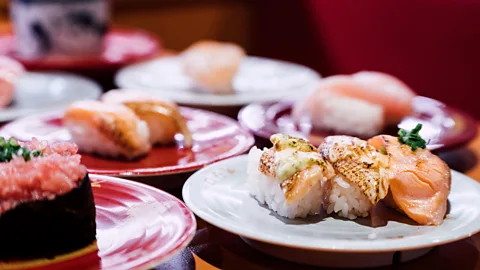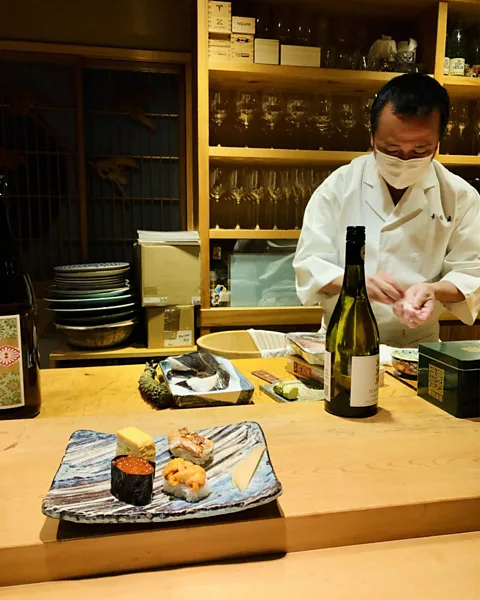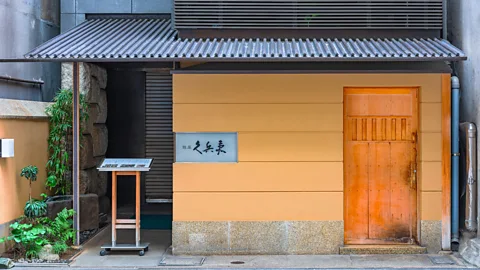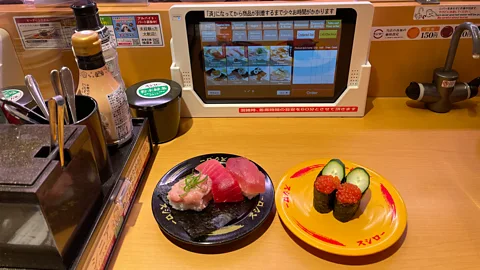Eat your way through Tokyo's best sushi
 Alamy
AlamyJapanese food author, reviewer and guide Yukari Sakamoto shares her picks of the five best sushi restaurants in the Japanese capital.
At first glance, Japan's most iconic food is a simple combination of seafood and bite-sized portions of rice. But like the culture it has come to represent, the world of sushi is full of subtlety, intricacy and history.

The SpeciaList
Yukari Sakamoto is the author of the book and blog Food Sake Tokyo, a qualified sommelier, shochu advisor and chef, and tour guide specialising in Tokyo's food markets and restaurants.
The most recognised version of sushi today – called nigirizushi or "hand-pressed sushi" – is a relative newcomer dating to the 1800s. However, the earliest version more than 1,000 years ago, called narezushi, saw rice and seafood fermented together before diners discarded the rice and ate only the preserved fish.
Today, sushi is a food that can cost pocket change at a bustling Japanese kaitenzushi (conveyor belt) joint or tens of thousands of yen in the hushed surrounds of the most exclusive sushiya (sushi restaurant). And beyond the classic nigiri, there are many sushi twists to discover in Tokyo, from pressed oshizushi and rolled makizushi.
No one knows the ins and outs of Tokyo's rich sushi scene better than the author of Food Sake Tokyo (and blog of the same name), Yukari Sakamoto. After reviewing countless sushi restaurants and guiding travellers through the city on food tours, we asked her to share some of the best places to experience sushi in Tokyo.
 Yukari Sakamoto
Yukari Sakamoto1. Best for omakase sushi: Sushi Yuu
The refined upper end of Tokyo's sushi scene can be intimidating for the uninitiated, especially with the language barriers many travellers encounter in Japan. Yet, that's not an issue at this laidback counter-only sushiya run by the English-speaking Japanese chef Daisuke Shimazaki in the quiet backstreets of Tokyo's Roppongi district.
Named after chef Shimazaki's grandfather, Sushi Yuu was originally opened by the chef's late-father, Shojiro, in the rather unfashionable district of Kameari in 1972, before relocating to Roppongi in the late 1970s, and finally its current location in 2010. Today, a photo of Shojiro sits behind Yuu's 11-seat, hinoki-cypress counter, from where Shimazaki serves classic nigirizushi in the omakase style, a term that translates as "I leave it up to you." That means instead of ordering from a menu, you'll be served a course chosen by Shimazaki based on the high-quality, in-season produce he sources each morning from Toyosu Market.
While the courses are all omakase, Sakamoto says maguro (tuna) is one highlight that always makes an appearance, whether that's the highly prized cuts of melt-in-the mouth o-toro or the meatier akami. And if you want an example of the fine details that make top chefs like Shimazaki different, Sakamoto recommends paying attention to the wasabi: as the tuna cuts get fattier, Shimazaki adds ever-so-slightly more of the warming condiment to cut through the fattiness and better balance out the flavours.
Address: 1-4-15 Nishi Azabu, Minato-ku, Tokyo 106-0031
Phone: +81 30 3403 6467
 Alamy
Alamy2. Best for accessible high-end sushi: Ginza Kyubey
Ginza is home to some of Japan's most vaunted and exclusive sushiya, but with Kyubey, which was opened in 1935 and is still run by the same family, Sakamoto says that this upmarket district also has a sushi legend that (while not cheap) is accessible to travellers.
Sushi etiquette, according to Yukari Sakamoto
• Mid- to high-end sushiya are calm, intimate spaces, so read the room when it comes to how loudly you speak.
• Speaking of manners, it's fine to eat nigiri with chopsticks or hands.
• At places where you need to dip the nigiri in soy, lightly dip the fish side only.
• In places where you need to apply wasabi yourself, don't mix it into the soy. Dab on a little wasabi separately.
One reason is its unusual scale for a high-end sushiya: there are five floors with a mix of intimate counter spaces, table seats and private rooms, plus an annex across the road and several branches in major hotels. Sakamoto says the staff are also used to dealing with non-Japanese guests and recommends Kyubey's lunchtime taster courses, which offer a more affordable way into this end of the sushi spectrum.
"The chefs at Kyubey serve fixed nigirizushi-focused courses that also include a type of wrapped sushi created by the first-generation owner Hisaji Imada in 1941 (and now a common sight in sushiya around the country)," Sakamoto says. "Called gunkanmaki, or 'battleship roll', it comes with dried seaweed (nori) wrapped around the sides of the rice to cradle soft toppings such as salmon roe (ikura) and sea urchin (uni) that would otherwise slip off a standard nigiri. In its day, it was a ground-breaking sushi innovation."
Address: 8-7-6 Ginza, Chuo-ku, Tokyo 104-0061
Phone: +81 3 3571 6523
 Rob Goss
Rob Goss3. Best for budget sushi: Sushiro
It speaks volumes of the quality of Tokyo's restaurants that one of the country's biggest budget sushi chains is well worth a recommendation. Sakamoto says this branch of Sushiro in the Yaesu underground mall at Tokyo Station – one of 60 in Tokyo and 639 nationwide – delivers the quintessential kaitenzushi conveyor belt sushi experience: bustling, fun, kid-friendly, cheap and – most importantly – good.
There's no need to stress over formality or language barriers here. As Sakamoto explains, you just take colour-coded dishes from the conveyor that passes near the seats, or use the multi-lingual touch screen to order direct from the kitchen (that arrives on a separate conveyor belt). There's plenty to choose from either way, with the 150 yen (£0.78) orange plates carrying nigiri such as squid and salmon, while the 210 yen (£1.09) red plates include sea bream nigiri and various gunkanmaki. Splurge on the 390 yen (£2.02) black plates for a single nigiri of higher-grade tuna.
Sakamoto says that what make Sushiro especially good for families or picky eaters is the range of non-nigiri options. With vegetarian nigiri and maki rolls, plus side dishes like small bowls of noodles, fries and fried chicken, there really is something for everyone. You even find combinations that might horrify a sushi purist: a prosciutto and mozzarella nigiri anybody? But why not? This is as much an authentic Tokyo sushi experience as anything else.
Address: 2-1 Yaesu, Chuo-ku, Tokyo 104-0028
Phone: +81 3516 31870
Website: https://www.akindo-sushiro.biz/en/
 Alamy
Alamy4. Best for carry-out sushi: Mitsukoshi
No, this isn't a sushi restaurant, but alongside a colourful array of deli counters, the basement-level of Japan's oldest department store is home to all sorts of sushi styles for takeout.
Yukari Sakamoto's Tokyo sushi tips
• For hard-to-come-by reservations at high-end sushiya, ask your hotel concierge for help or try a service like Pocket Concierge or Table All.
• For fresher food at kaitenzushi, order from the touch-pad screen at your seat instead of taking older dishes off the conveyor belt.
• Don't let sushi sit. It's designed to be the perfect temperature when it arrives, so eat straight away.
Sakamoto especially likes the stall for Shinodazushi, whose main shop in nearby Kanda has been in business since 1877. It specialises in inarizushi (pockets of deep-fried tofu stuffed with vinegared sushi rice) and makizushi (thin rolls featuring toasted nori seaweed wrapped around rice and a central filling such as pickles and cucumber). While both of these styles are common sights in sushiya, supermarkets and convenience stores, Sakamoto says that what makes Shinodazushi so unique is that it also sells the less-common oshizushi, where toppings like mackerel and salmon are placed on a wooden box full of vinegared sushi rice and then tightly pressed.
Across from Shinodazushi, Gozaemonzushi sells a twist on the oshizushi theme, and Sakamoto recommends ordering the mackerel pressed onto rice accented with sesame seeds and then wrapped in kombu kelp. Elsewhere, you'll find normal nigiri sets and variations like chirashizushi, which sees a mix of chopped sushi toppings scattered over a bed of rice. Even if you just come to browse, Sakamoto says it all serves to highlight the incredible variety of sushi available in Tokyo.
After browsing the stalls, she suggests taking your takeaway sushi up to the tables in Mitsukoshi's peaceful rooftop garden.
Address: 1-4-1 Nihonbashi Muromachi, Chuo-ku, Tokyo 103-8001
Phone: +81 3 3241 3311
Website: https://www.mistore.jp.e.az.hp.transer.com/store/nihombashi.html
 Rob Goss
Rob Goss5. Best for value: Manten Sushi
Located in the plush Coredo Muromachi commercial complex in Nihonbashi, Manten Sushi is something of an outlier. Not only does the 20-seat eatery open on Sundays, when many mid- to high-end sushiya and the main seafood market are closed, it manages to deliver highly rated omakase-only courses at the kind of prices that should make some ultra-expensive sushiya blush: 3,500 yen (£18.15) at lunch and 7,000 yen (£36.95) at dinner. Compare that to 55,000 yen (£285) at the legendary sushi restaurant Jiro in Ginza.
Because omakase allows free rein for chefs to focus on in-season produce and daily market finds, Sakamoto says one of Manten's greatest charms is that you'll never know exactly what the chefs will pass over the wooden counter. It might start with an umami-rich clam soup to invigorate the palate before nigiri that the chefs will have brushed with just the right amount of soy. You might even get the occasional non-seafood surprise, like a nigiri topped with chewy enoki mushrooms, or a shellfish or two.
If you can't get a reservation (and they are strongly recommended), Sakamoto suggests checking out their other branches not far away in Hibiya and Marunouchi.
Address: 2-3-1 Nihonbashi Muromachi, Chuo-ku, Tokyo 103-0027
Phone: +81 3 3277 6045
Website: https://www.manten-sushi.com/
BBC Travel's The SpeciaList is a series of guides to popular and emerging destinations around the world, as seen through the eyes of local experts and tastemakers.
--
If you liked this story, sign up for The Essential List newsletter – a handpicked selection of features, videos and can't-miss news, delivered to your inbox twice a week.
